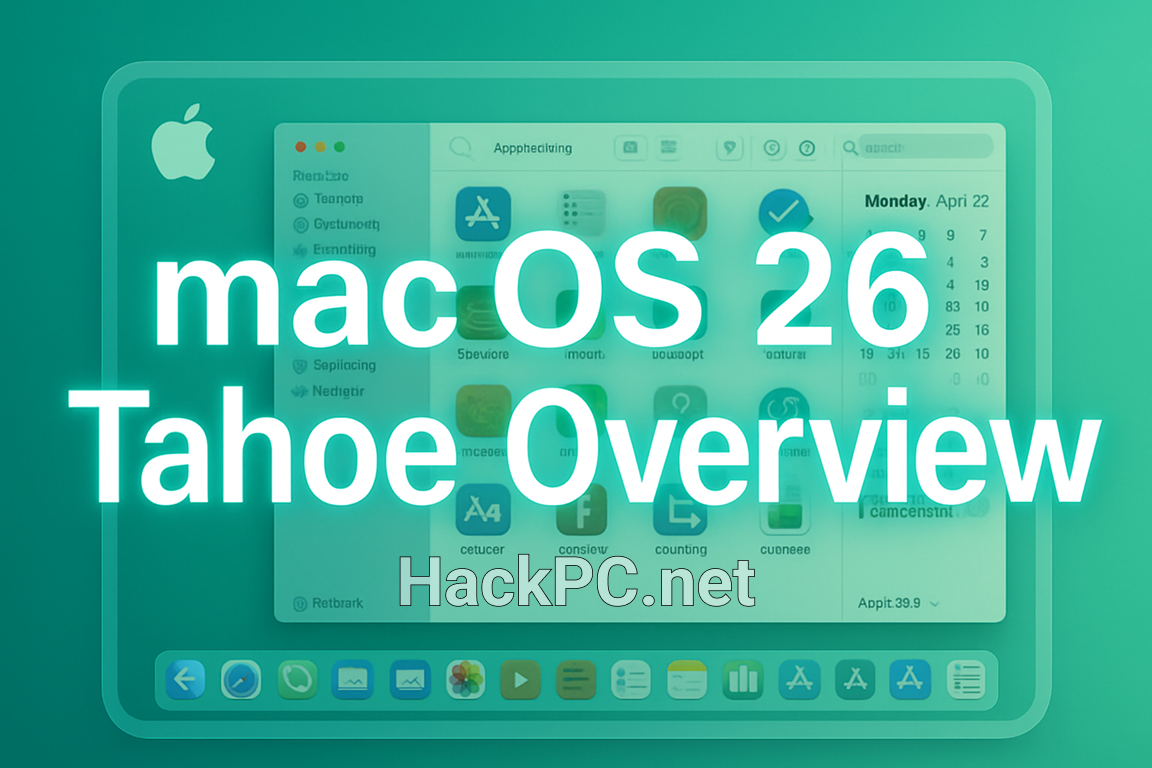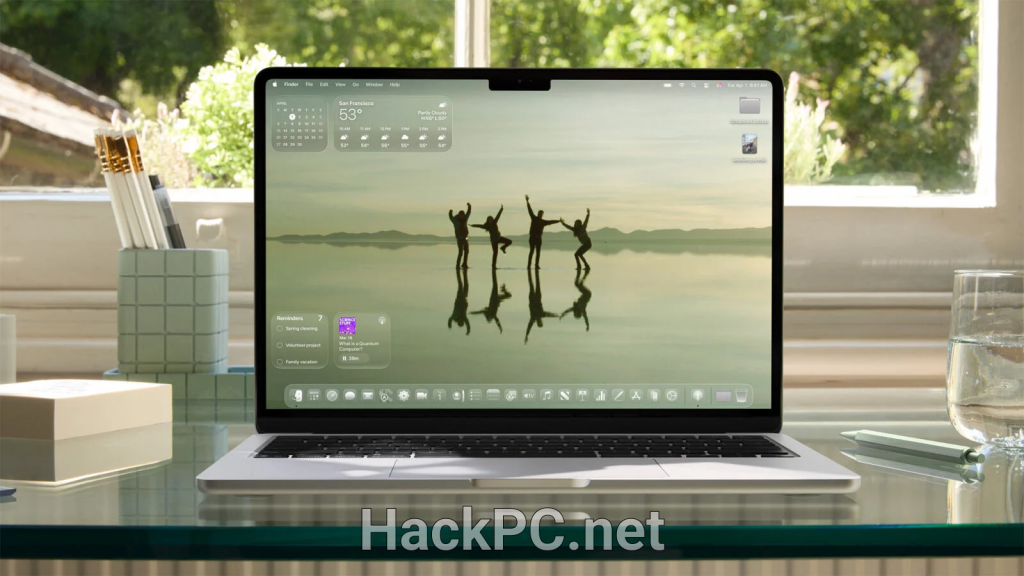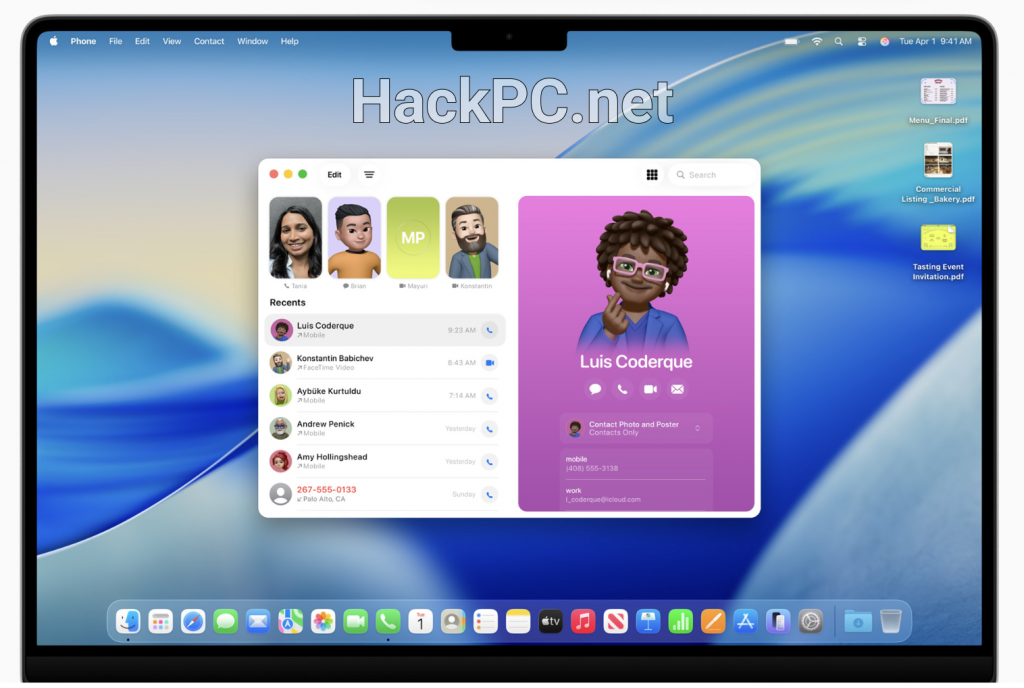
September’s arrival brings more than falling leaves—it marks the anticipated launch of macOS 26 Tahoe, Apple’s most ambitious desktop operating system update since Big Sur. Named after California’s pristine alpine lake, this major release promises to transform how millions interact with their Macs through revolutionary design changes, sophisticated security enhancements, and seamless ecosystem integration.
The Liquid Glass Revolution: A Visual Renaissance for Mac
The centerpiece of macOS Tahoe is undoubtedly the Liquid Glass design language—a visual overhaul that fundamentally reimagines the Mac interface. This translucent material design behaves like actual glass, refracting and reflecting content in real-time while bringing unprecedented clarity to navigation controls. Sidebars and toolbars now feature dynamic transparency that adjusts based on your workspace, creating depth that makes your display feel physically larger.
Mac users upgrading from Sequoia will immediately notice the transparent menu bar, which seamlessly blends with wallpapers to maximize screen real estate. The new aesthetic extends beyond mere appearance—it represents a philosophical shift toward content-focused computing where interface elements gracefully recede when unnecessary.
Application windows in Tahoe showcase this philosophy beautifully. The redesigned Terminal app, supporting 24-bit color and Powerline fonts, exemplifies how professional tools can embrace modern aesthetics without sacrificing functionality. Every system application, from Finder to Safari, benefits from this cohesive visual language that unifies Apple’s entire ecosystem.
Personalization Without Boundaries
Customization reaches new heights with Tahoe’s expanded personalization options. Mac enthusiasts can now choose between Light, Dark, Tinted, or the stunning new Clear appearance for app icons—matching the transparency options introduced in iOS 26. Folder customization goes beyond simple color coding. Users can add emojis, symbols, and distinctive colors to create instantly recognizable organizational systems.
The revamped Control Center brings iOS-style customization to the desktop, allowing third-party app integration directly into system controls. Whether you’re adjusting Parallels Desktop settings or managing smart home devices, everything lives harmoniously within the unified control interface.

Security Architecture: Privacy-First Computing
Apple’s commitment to user privacy manifests powerfully in Tahoe’s security infrastructure. The operating system introduces granular permission controls that give users unprecedented visibility into how applications access system resources. Background process management receives particular attention, with new restrictions ensuring applications cannot silently consume resources or access data without explicit authorization.
Apple Support documentation highlights enhanced on-device processing for sensitive operations, minimizing data transmission to external servers. The new spam detection system for Messages operates entirely locally, identifying and filtering unwanted communications without compromising message privacy.
Gatekeeper improvements add another security layer, with enhanced notarization requirements for third-party software. These changes might initially frustrate power users accustomed to installing unsigned applications, but they significantly reduce malware risks for average consumers.
Apple Intelligence: The Brain Behind the Beauty
Machine learning integration permeates every corner of macOS Tahoe through Apple Intelligence features. The reimagined Spotlight Search transforms from a simple launcher into an intelligent assistant capable of executing hundreds of keyboard-driven actions. Natural language processing allows conversational queries like “show me documents I edited last Tuesday about the quarterly report” to surface relevant results instantly.
Reminders showcase Apple Intelligence’s practical applications through automatic task categorization and smart suggestions based on email content and calendar events. The system learns your organizational preferences over time, suggesting grocery items, follow-ups, and project tasks without manual configuration.
Live Translation in FaceTime breaks down language barriers during video calls, providing real-time captions for multilingual conversations. This feature, exclusive to Apple silicon Macs, demonstrates how hardware and software integration enables capabilities impossible on generic platforms.
Ecosystem Harmony: Continuity Redefined
The new Phone app for Mac exemplifies Tahoe’s enhanced Continuity features, enabling cellular call relay from nearby iPhones with unprecedented reliability. Call Screening intelligently identifies unknown callers, displaying their purpose before interrupting your workflow. Hold Assist maintains your position in customer service queues, notifying you when representatives become available.
iPhone Mirroring receives substantial improvements, with Live Activities from your iPhone appearing directly in the Mac menu bar. Clicking these notifications opens the corresponding app through iPhone Mirroring, enabling seamless interaction without reaching for your phone. This integration extends to the new Applications interface—replacing the dated Launchpad—which displays iPhone apps alongside Mac applications for unified access.
Gaming and Entertainment Evolution
Gaming enthusiasts will appreciate the dedicated Games app, which consolidates titles from multiple sources into a unified library. The Game Overlay enables system adjustments, friend chat, and multiplayer invitations without leaving fullscreen gameplay. Metal 4 brings advanced graphics technologies like MetalFX Frame Interpolation and Denoising, pushing Mac gaming capabilities closer to dedicated gaming platforms.
TechRadar reports that early testers praise the performance improvements in graphics-intensive applications, though compatibility with older games remains a concern for some users.
Productivity Powerhouse Features
Journal finally arrives on Mac, synchronizing entries across devices through iCloud while maintaining end-to-end encryption. The Mac implementation surpasses its iOS counterpart with rich text formatting, multimedia embedding, and advanced search capabilities that make retrospective reflection genuinely valuable.
Messages receives substantial upgrades beyond visual improvements. Polls enable group decision-making with up to twelve options, while participants can add choices dynamically. Typing indicators in group chats show exactly who’s composing responses, reducing conversation overlap. Background customization with photos or Image Playground creations personalizes conversations for all participants.
The streamlined conversation details interface organizes contact information, shared media, links, and locations into dedicated sections, making historical content easily accessible. Spam filtering and Unknown Senders categorization help maintain focus on meaningful communications.
Accessibility: Computing for Everyone
Vehicle Motion Cues, successfully deployed on iPhone, now helps MacBook users reduce motion sickness during travel. The system displays subtle moving dots that help your brain reconcile screen content with physical movement—particularly valuable for professionals working during commutes.
Expanded Braille display support and the system-wide Accessibility Reader ensure Tahoe remains usable for users with varying abilities. These aren’t afterthoughts but integral features developed alongside mainstream functionality.
System Requirements and Compatibility
MacRumors confirms that Tahoe supports all Apple silicon Macs plus select Intel models featuring 9th-generation Coffee Lake Refresh processors or newer. This includes:
- All M1, M2, M3, and M4-based Macs
- MacBook Pro (16-inch, 2019)
- MacBook Pro (13-inch, 2020, Four Thunderbolt ports)
- iMac (2020)
- Mac Pro (2019)
Intel-based MacBook Air and Mac mini models lose support with this release, marking the beginning of Apple’s transition away from Intel architecture. Users with unsupported hardware should consider this natural upgrade opportunity, as future macOS versions will exclusively target Apple silicon.
Performance and Battery Optimization
Initial benchmarks suggest Tahoe optimizes resource utilization effectively, with Apple silicon Macs experiencing 10-15% improved battery life during typical workflows. The operating system’s intelligent scheduling ensures background tasks execute during optimal conditions, reducing unnecessary wake cycles.
Memory management improvements particularly benefit users running multiple professional applications simultaneously. The system more aggressively compresses inactive memory while maintaining responsiveness, effectively providing additional headroom for demanding workflows.
Developer Considerations
Developers face significant changes with Tahoe’s enhanced security model and Liquid Glass requirements. Applications must adopt new transparency APIs to integrate seamlessly with system aesthetics, while updated entitlements ensure compatibility with stricter privacy controls.
The removal of Launchpad affects application discovery mechanisms, requiring developers to optimize metadata for the new Applications interface. Tom’s Guide notes that early developer feedback suggests adaptation requires minimal effort for well-maintained applications.

Installation and Migration Tips
Upgrading to macOS Tahoe requires careful preparation. Create comprehensive Time Machine backups before initiating installation, as the update modifies core system components extensively. Users should allocate at least 20GB of free storage for the installation process, though 30GB provides comfortable overhead.
The installation eschews Mac App Store distribution, available exclusively through System Settings’ software update panel—similar to iOS update mechanisms. This change streamlines the update process while ensuring proper system verification before installation begins.
Third-party software compatibility varies significantly. Business Standard recommends checking with software vendors before upgrading, particularly for professional creative applications and system utilities that interact with low-level system functions.
Future-Proofing Your Mac Experience
macOS Tahoe represents more than an annual update—it’s a statement about computing’s future direction. The unified version numbering across Apple’s platforms (iOS 26, iPadOS 26, watchOS 26, tvOS 26, and visionOS 26) signals tighter integration moving forward. Users investing in the Apple ecosystem will find increasing value as features seamlessly traverse device boundaries.
The emphasis on Apple Intelligence suggests future updates will further leverage machine learning for personalization and automation. Users should expect their Macs to become increasingly predictive, anticipating needs based on usage patterns and contextual awareness.
Conclusion: A Watershed Moment for Mac
macOS 26 Tahoe achieves the delicate balance between revolutionary change and evolutionary refinement. The Liquid Glass design provides visual distinction without sacrificing usability, while security enhancements protect users without creating friction. Integration features transform multiple Apple devices from independent tools into a cohesive computing environment.
Power users might initially resist certain changes—particularly the Applications interface replacing Launchpad and stricter security requirements. However, these modifications reflect computing’s trajectory toward simplicity, security, and seamless experiences across devices.
For professionals, creative users, and everyday consumers alike, Tahoe offers compelling reasons to upgrade. The combination of aesthetic refinement, productivity enhancements, and ecosystem integration creates a desktop operating system that feels simultaneously familiar and refreshingly modern. As Apple continues pushing boundaries while respecting user expectations, macOS Tahoe stands as testament to what’s possible when hardware and software development proceed in perfect harmony.
The journey from Monterey through Big Sur and Ventura to Sequoia has prepared users for this moment. Tahoe doesn’t just iterate on previous releases—it synthesizes years of learning into a coherent vision for desktop computing’s next chapter. Whether you’re editing videos, developing applications, managing business operations, or simply staying connected with loved ones, macOS 26 Tahoe provides the foundation for whatever comes next in your digital journey.



Comments (0)